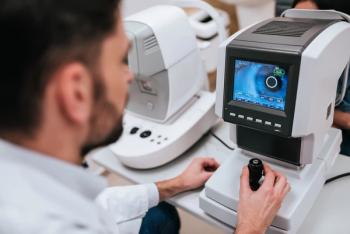
- September/October digital edition 2025
- Volume 17
- Issue 05
Lens-based refractive surgery is carving out a growing niche
Consider these tips for educating patients on additive, lens-based vision correction.
One of the most important communication tasks I have as an OD is to simplify what can be a complex decision-making process for the patient.
Optometrists are often the first to educate patients about refractive surgery, which gives us an extraordinary opportunity and responsibility to ensure that they understand the full spectrum of available options and which ones are best suited for them. Most patients who are open to the idea of refractive surgery are somewhat knowledgeable about LASIK and other corneal-based procedures, such as photorefractive keratectomy (PRK) and small incision lenticule extraction. Conversely, few are familiar with the EVO implantable collamer lens (ICL; STAAR Surgical Company), which I am finding to be one of the most exciting and transformative refractive procedures that we have integrated into our comanagement workflow here at ICON Eyecare in Denver, Colorado.
Additive vision correction
One of the most important communication tasks I have as an OD is to simplify what can be a complex decision-making process for the patient. When introducing EVO ICL, I begin by emphasizing the concept of “additive” vision correction. This framing helps patients immediately distinguish it from more familiar procedures that reshape the cornea. I explain that instead of removing any part of their eye’s natural anatomy, EVO ICL adds something to enhance it. Specifically, the EVO lens is placed behind the iris, where it works in harmony with the natural lens to correct vision, most commonly for myopia and astigmatism. It’s invisible to the naked eye, patients typically can’t feel it once implanted, and it doesn’t interfere with normal ocular function. Patients tend to respond well to this easy-to-understand language. I also highlight that, unlike corneal-based surgeries, EVO ICL is removable. This reversibility provides peace of mind, especially to younger patients who may be concerned about the long-term evolution of their vision.
It is also helpful to mention that the collamer material used in the lens is biocompatible and includes collagen, which enhances its acceptance in the eye. The fact that more than 2 million lenses have been implanted worldwide, with extremely high patient satisfaction, also helps reinforce confidence in
the technology.
Identifying ideal candidates
Although LASIK and PRK remain good choices for many, there is a significant cohort of patients who either are not candidates or would benefit more from EVO ICL. My role as a comanaging optometrist is to identify those patients early and educate them on the best available options. Patients with moderate to high myopia (typically –3.00 diopters [D] to –20.00 D) often fall into the sweet spot for EVO ICL. Many of these patients are either not eligible for LASIK due to thin corneas or are uncomfortable with the idea of permanently reshaping their eyes. Others may have large pupils and are concerned about night vision, an area where EVO ICL performs very well.
I have also seen strong interest from patients who are especially concerned about dry eye symptoms, either because they already struggle with ocular surface discomfort or because they have read about the risks of dryness after LASIK. Because EVO ICL does not disrupt the corneal nerves, it has a far lower incidence of postoperative dry eye, making it ideal for this subgroup.
Younger adults, especially those in their 20s and early 30s, are increasingly open to EVO ICL as an alternative to LASIK. As long as their refraction has stabilized, I do not hesitate to start the conversation, provided they have realistic expectations and understand that no vision correction procedure is immune to future changes in prescription or the onset of presbyopia. I am comfortable telling patients that if they want to be out of glasses for their entire life going forward, the ICL will set them up for better success than the other available options.
Communication strategies
Educating patients about EVO ICL starts with creating a relatable framework for decision-making. Most people coming in for refractive evaluations have heard of LASIK. Part of my job is to present EVO ICL not as a backup option but as an equally valid and, in some cases, superior alternative based on their unique ocular anatomy and lifestyle needs.
Another communication pearl is highlighting the long-term flexibility of EVO ICL. Unlike corneal ablation procedures, the lens can be removed or exchanged. If the patient develops cataracts later in life, for example, the EVO lens can be taken out at the time of cataract surgery. That built-in adaptability gives many patients the confidence they need to move forward.
I also make sure to contrast the invasiveness of various procedures. Many patients assume that EVO ICL is more invasive because it involves surgically entering the eye, but in reality, the procedure is quick, painless, and minimally traumatic to ocular tissue. Most patients experience a rapid recovery and are back to normal routines within a few days.
In an age where patients are increasingly savvy and driven by data, I find it useful to reference satisfaction and outcome statistics. Knowing that 99% of patients report satisfaction1 and that EVO ICL offers excellent vision quality even in low-light conditions adds clinical credibility to the conversation.
Finally, I tailor the message to the individual’s motivations. Some are focused on visual performance, others on safety, and still others on long-term flexibility. When I align my message with their values and concerns, the conversation becomes collaborative rather than persuasive.
Comanaging in a busy practice
Comanaging patients with EVO ICL has become a seamless part of our clinic’s workflow. With the right systems in place and close collaboration with our surgeons, it’s possible to deliver an exceptional patient experience while minimizing disruptions to day-to-day operations. The process typically begins with a comprehensive refractive evaluation. In addition to standard refraction, I assess corneal thickness, anterior chamber depth, and endothelial cell count. If the patient appears to be a strong candidate for lens-based correction, I introduce the concept and provide educational materials. I then refer the patient to one of our surgical partners for confirmation of candidacy and surgical consultation.
Postoperatively, I handle the 1-day, 1-week, and 1-month follow-up visits. Patients are generally delighted with their vision and appreciate that they’re returning to the eye doctor they know and trust for their follow-up care. That continuity helps reinforce our role as long-term partners in their visual health.
Comanaging EVO ICL is highly efficient in terms of workload. Once you establish protocols, the preoperative and postoperative care fall neatly into a typical patient schedule. From a business perspective, it diversifies our services and enhances our value in the eyes of patients and surgical collaborators.
Building trust
As additive lens-based technologies become more mainstream, optometrists are uniquely positioned to guide patients through this evolving landscape. EVO ICL represents a safe, effective, and elegant solution for a growing number of patients seeking freedom from glasses and contacts, and they’re often hearing about it from us first.
Educating patients about EVO ICL requires clarity, empathy, and a genuine belief in its benefits. When we can explain it effectively, tailor the message to patient priorities, and collaborate efficiently with our surgical colleagues, we not only refer patients but also empower them to make informed, confident decisions about their vision.
Bringing EVO ICL into my comanagement portfolio has not only expanded the options I can offer, but it has also deepened the level of trust patients place in my care. And in today’s competitive eye care environment, that trust is the most powerful currency we have.
Reference
Patient survey, STAAR Surgical ICL Data Registry. 2018.
Articles in this issue
about 1 month ago
Reflex for stabilizing vision develops without sensory inputabout 1 month ago
The emerging era of presbyopia-correcting eye drops: What’s next?about 2 months ago
So you want to create a private label eyewear brand?3 months ago
Top-line DEWS III updatesNewsletter
Want more insights like this? Subscribe to Optometry Times and get clinical pearls and practice tips delivered straight to your inbox.













































